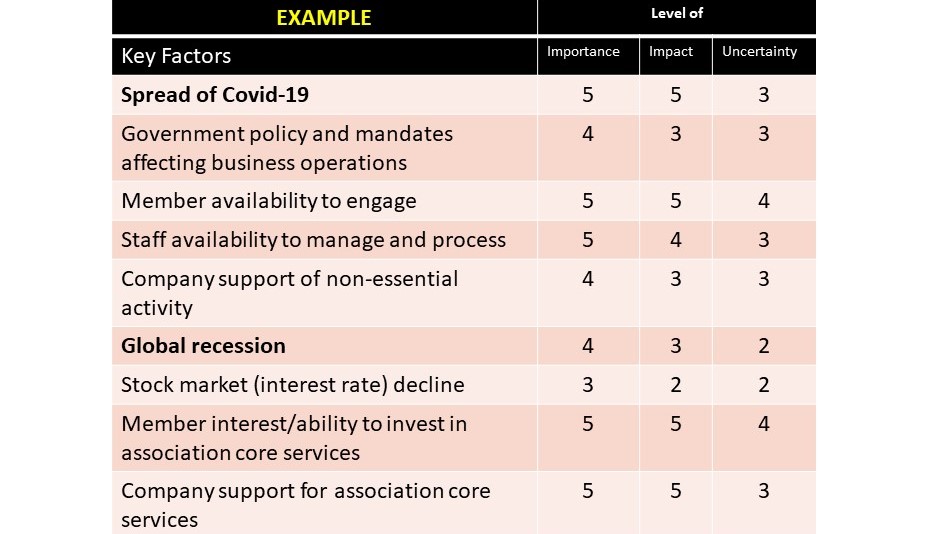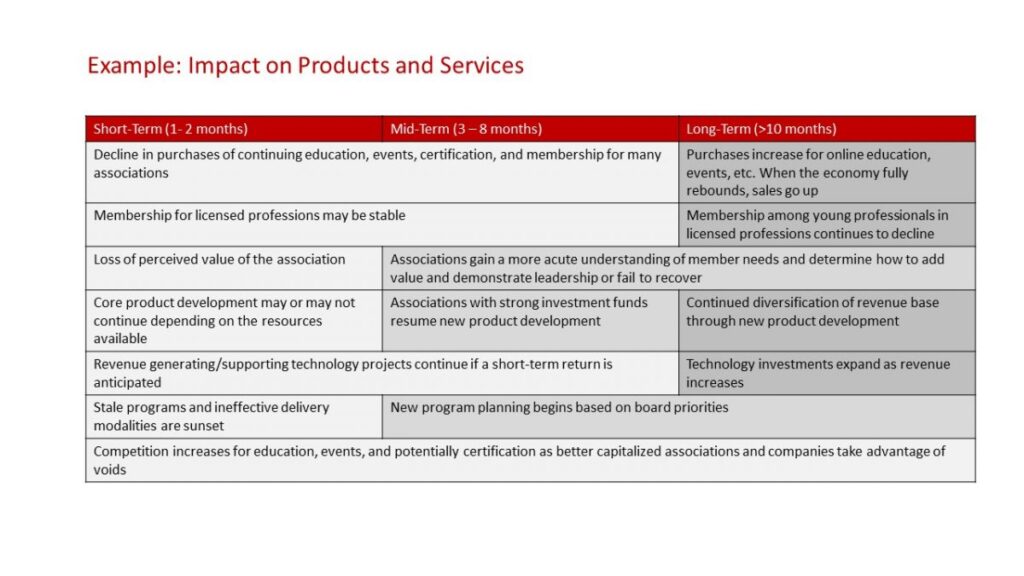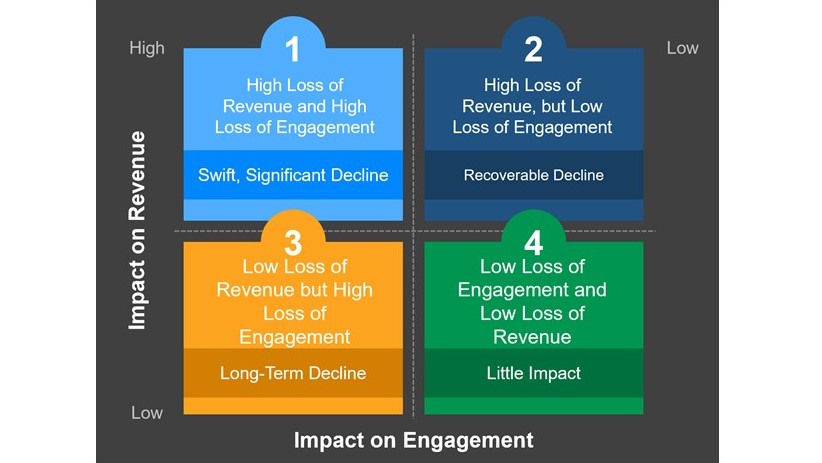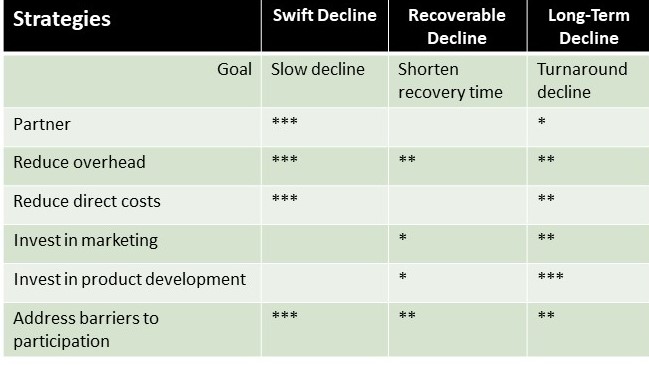Scenario Planning Builds a Resilient Future

Should we cancel the conference? Are layoffs needed to keep the organization afloat? How much of the reserves can we safely spend?
Responsibility for the decisions that make or break an organization is the tough side of leadership. Selling a solution to everyone who must agree can be even harder. But you don’t need nerves of steel and a will of iron to survive. Having problem-solving strategies at the ready and understanding how to use them effectively will pay you back in hours of lost sleep, make you feel better about going to work and give you a tool to build a more resilient association.
Be Ahead of the Curve
One way to avoid the most challenging calls is to stay ahead of them. Scenario planning helps you to see around the corners. At .orgSource we talk a lot about the value of adaptability—or the willingness to pivot when plans are derailed by the unexpected. Scenario planning allows you to develop short, mid, and long-range strategies with flexibility baked into the design. It can also help gain traction in a crisis.
Sharon Rice, .orgSource’s Managing Director, Business Strategy, explains it like this: “Scenario planning fills you with information and an understanding of the possibilities. It gives you some control when the external environment is rapidly changing, and people are looking to you for leadership. Understanding the potential futures steers decision-making away from reaction and towards positive action.”
Scenario planning can be quite complex. But for a recent webinar, Rice created a “just in time” process. This methodology can be used to quickly answer critical questions surrounding any pressing issue, including the COVID-19 crisis.
Get Answers
“The most important thing about scenario planning,” Rice notes, “is that it gives us direction, and that’s what we’re looking for in an acute situation.” The process revolves around six core questions:
1. Why are we engaged in planning now?
Rice recommends limiting the initial stages of planning to the organization’s key leaders. To put the team on the same page, it’s important to have a clear understanding of what you are seeking to accomplish. She provided this example of a statement of intention:
Today we are facing two separate but related challenges to the way we do business, COVID-19 and the potential for a global recession. These events are likely to have a profound impact on our members, staff, leaders, customers and our entire association in the short and mid-term. There are likely to be long-term consequences as well. Our goal in scenario planning is to fully explore the impact of these events and develop a plan that will support us in making decisions for our association.
2. What are the factors that are driving uncertainty and how impactful could they be?
This is the environmental assessment phase of the process. The goal is to identify the external issues surrounding the situation. These will be factors that are outside of the association’s control. If you are fortunate enough to have a research department, enlist them to help gather the data. Using the example of COVID-19, you will investigate issues such as:
- Government policies and mandates affecting business operation
- Member availability to engage. Does the event threaten to co-opt your relationship with your constituents? How distracted are they?
- Staff availability to manage and process. As you shift to remote work, will staff have difficulty adjusting?
- Company support of non-essential activity. How are your members’ companies or industries restricting their employees’ activities?
To determine which challenges must be addressed first, each issue is rated from 1 (low urgency) to 5 (most urgent) in three areas.
- Importance—How significant is this issue to your business?
- Impact—How urgent is it to address the problem?
- Uncertainty—How unpredictable is the situation?
By adding the rankings from left to right on a grid like the one below, it becomes easy to see where to focus attention:

Although this exercise is somewhat subjective, it provides an opportunity for in-depth discussion and building consensus among the team.
3. What are the potential short, mid, and long-term impacts?
Now you are ready to begin forecasting. To explore the impacts on your association, you will probably want to expand the number of staff who participate in the process. Depending on the size of the organization, you might include department heads and managers.
In a crisis, the discussion may be challenging. However, Rice advises that transparency has many benefits. Reviewing the outcomes together, even when they may be negative, promotes a feeling of solidarity and collaboration. It sends the message that although difficult times lie ahead, the organization has a plan. Participating staff can share the experience with their colleagues giving everyone a greater sense of stability.
“Although the predictions you make will vary from what actually happens, they will allow you to develop short, mid-term and long-range goals for moving forward. Your objectives can be adjusted along the way as circumstances change and new information becomes available,” Rice notes.
After you’ve identified impacts, you’ll want to evaluate their effect on key areas such as: members and customers, products and services, finance, operations and governance. Each business line will have its own set of impacts. Rice provided this example from a recent meeting with a group of association CEOs who discussed the impacts of COVID-19.

4. What are the possible scenarios we are facing?
The data created in step 3 is the basis for building scenarios around which plans will be developed. Rice recommends that to keep the process manageable, first-timers should limit themselves to 3 to 5 choices. She notes that speed is of the essence. “In a crisis, this exercise must be completed rapidly. Perfection isn’t necessary. After a baseline is established, improvements can be made as you move forward,” she advises.
Rice and the CEO group created these four scenarios as possible outcomes of COVID-19.

The scenarios can be formatted in many different ways. Rice used a matrix to illustrate the CEO group’s thinking.
To complete this step, the scenarios (except quadrant 4, since no action is required) would be fully described and evaluated. A projection would be made for how likely each situation is to occur.
5. What key indicators will show that we are moving closer to a scenario?
You can use both internal and external metrics to indicate when the organization might be moving closer to one of the scenarios. Indicators related to COVID-19 might include:
External Internal
Infection Rate Total Revenue
Mortality Rate Net Revenue
Hospitalization Rate Member Retention
Virus Abatement Date Member Acquisition
Economic Decline Engagement
6. What will the operating strategy be for each scenario?
The final step is to set goals along with related strategies and tactics for each scenario. In a long-range planning exercise, these could be quite complex. However, in a crisis, Rice recommends expedience.
For example, in scenario 1 or the most acute situation, the goal will be to stop the bleeding so that the organization can move into a recoverable decline, or scenario 2. Cost reduction will certainly be a high priority.
In the table below, strategies are ranked from 1 (low) to 3 (high) based on their importance to each of the goals. Rice emphasized that financial modeling to support this planning is hugely important. You’ll need a solid understanding of the budgetary implications of all your activities.

Lead the Effort
Scenario planning and other decision-making frameworks are a path to a more resilient future. But leadership is the bottom line, according to Rice. In a crisis, to move the organization forward and to ensure that everyone is pulling together, the CEO must communicate:
• Where we are
• How we got here
• And, where we are going to go
That is the leader’s most important job. Scenario planning will help you to fulfill your responsibility effectively.
To learn more about scenario planning and other crisis response strategies watch this webinar.
As a leader in digital transformation, .orgSource can guide you through the ins and outs of scenario building and other problem-solving strategies. Get started today. Click here to schedule a short consultation with me. I am always eager to meet new colleagues and discuss how .orgSource can position your association for success.
